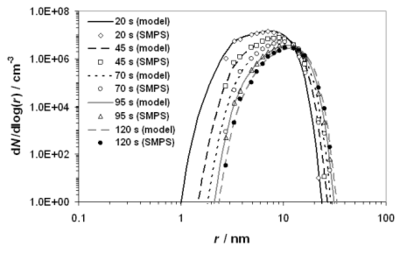Particle formation
Lower Atmosphere – Modelling
Iodine oxide particle (IOP) growth modelling
Measured time-resolved particle size distribution data was used to develop a coagulational growth model which accounts for the growth of fractal IOP's with open, low density structures as observed in laboratory work on IOP's, whilst taking into account inter-particle, short-range van der Waals interactions and hydrodynamic forces (Saunders and Plane, 2006).
An example of the model fits to a time series of size distribution data is shown in Figure 1. The best-fit procedure allowed for estimation of the parameters of fractal dimension (Df) and primary particle size (r0) used to characterise all fractal forms.

Figure 1. Comparison of model fits (lines) to the measured distributions (discrete points) at the coagulation times indicated. Best-fit parameter values were as follows; r0 = 3.3 nm (all times), Df = 2.2 (20 s), 2.4 (45 s) and 2.5 (70, 95 and 120 s). For all fits, particle density was calculated from the relevant r0 and Df values and coagulation started at rn=1 = 0.30 nm, corresponding to the size of a single I2O5 molecule - Figure taken from Saunders and Plane (2006)
The modelled value of Df = 2.5 at the longest growth times is consistent with the particle-cluster diffusion limited aggregation (DLA) mechanism.
References
Saunders, R.W., and J.M.C. Plane, Fractal growth modelling of I2O5 nanoparticles. J. Aerosol Sci., 2006, 37, 1737.
